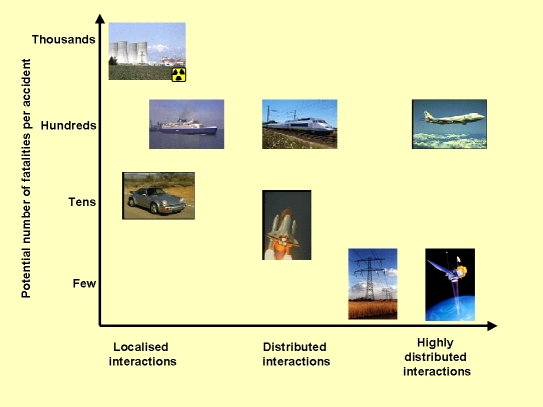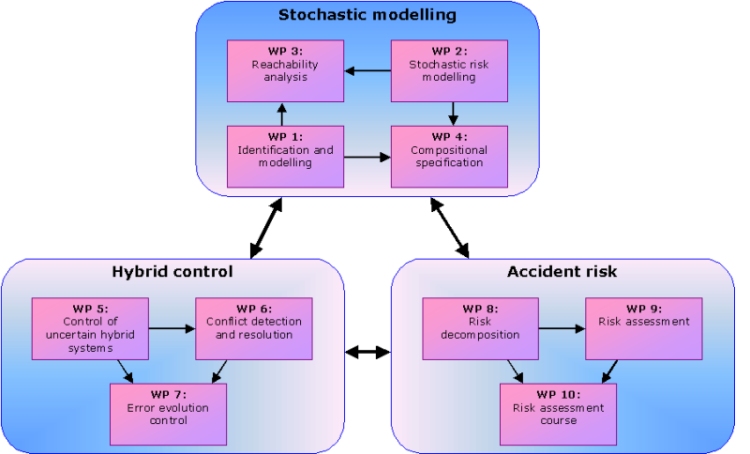HYBRIDGE Project Presentation
- Project details
- Project objective(s)
- Description of the work
- Technical approach
- Milestones and expected results
1. Project details
| Contract number | IST-2001-32460 |
| Project acronym | HYBRIDGE |
| Project name | Distributed Control and Stochastic Analysis of Hybrid Systems Supporting Safety Critical Real-Time Systems Design |
| Project period | January 2002 - December 2004 |
| Key action | IST-2001-IV.2.1 (iii) |
| Action line | Distributed Control |
| Total project cost | 4,000 kEuro |
| IST European Commision funding | 2,400 kEuro |
Top
2. Project objective(s)
The 21st century finds Europe facing a number of remarkable changes, many of which
involve large complex real-time systems the management and control of which undergoes
a natural trend of becoming more and more distributed while at the same time the safety
criticality of these systems for human society tends to increase. However good the control
design for these systems will be, humans are the only ones carrying responsibility for
the operational safety. This implies that control system designs for safety critical
operations have to be embedded within sound safety management systems such that the
level of safety stays under control of humans. The objective of HYBRIDGE is to
develop the methodologies to accomplish this, and to demonstrate their use in
support of advanced air traffic management design.
In addition to direct application to air traffic management, these contributions
form the nucleus for further research and development into a complex, uncertain
system theory, and into application of this theory to distributed control of other
real time complex systems such as communication, computer and power networks.

Top
3. Description of the work
In order to lay the foundations for a systems theory for safety critical complex uncertain systems, the challenging developments are organised in clusters of innovative areas:
Characterise in mathematical terms the relations between various mathematical models that are in use by the various hybrid systems researchers. Key examples are Automation models, Petri net models, Piecewise Deterministic Markov Processes and Stochastic Differential equations on an hybrid state space and Hierarchical control models.
Develop architectures and algorithms for distributed conflict control and error evolution control for safety critical systems which are embedded within safety management.
Development of stochastic analysis based accident risk assessment methodology which supports the design of distributed control of complex systems for safety critical operations.
The interplay between these areas is shown through the demonstration of these results on working examples and risk assessment courses to learn others how these results are used in practice. For the realisation of this we will systematically refer to the design of advanced air traffic management, since:
It is well known as one of the most complex distributed safety critical systems,
It allows to show how the different HYBRIDGE developments complement each other, and
It supports the urgent need of innovative approaches in advanced ATM developments.
4. Technical approach
An important rationale underlying the technical approach of the HYBRIDGE project has been the desire to subdivide the work into well-defined work packages that can be handled in parallel by different partners from the consortium in such a way that their specific and often unique background is used to the full extent. The working principle has been that the university researchers shall put their ingenuity and theoretical system/control background into the specific area of a complex operation like air traffic. For leaders of work packages the specific selection of their preferred topic is up to them, under the explicit condition that their approach should be such that at least one of the non-university partners is enthusiastic in providing the necessary support towards connecting the abstract theories to relevant air traffic situations. This rationale ensures to a large extent that each work package leader is able to achieve an effective execution of the research, within the time frame and in an efficient way being able to accept the responsibility for realising the measurable objectives of his work package(s). In view of this, the main risk that remains is coming from the possibility that the availability of the key researcher of a work package leader becomes a problem. In such case it is the responsibility of the Co-ordinator to identify an appropriate way to solve this problem. Following this rationale we arrived at breakdown of the work into ten technical work packages. These ten work packages have been clustered around the Core Innovation areas I, II and III as follows (see also Figure below):
-
Stochastic hybrid modelling cluster, containing four work packages:
-
WP1: Identification and modelling of uncertain hybrid systems (Partner UCAM leads)
-
WP2: Stochastic hybrid systems based modelling of accident risk (Partner NLR leads)
-
WP3: Reachability analysis for probabilistic hybrid systems (Partner UniBs leads)
-
WP4: Compositional specification of stochastic hybrid systems (Partner TWEN leads)
-
-
Distributed Control theory cluster, containing three work packages
-
WP5: Control of uncertain hybrid systems (Partner UCAM leads)
-
WP6: Decentralized conflict prediction and resolution (Partner NTUA leads)
-
WP7: Error evolution control (Partner AQUI leads)
-
-
Distributed Control Risk Assessment cluster, also containing three work packages
-
WP8: Accident risk decomposition (Partner TWEN leads)
-
WP9: Perform risk assessment of distributed control system (Partner NLR leads)
-
WP10: Develop advanced risk assessment course (Partner NLR leads)
-

Top
5. Milestones and expected results
The HYBRIDGE project has several concrete milestones:
Methods for modelling, analysing and verifying complex uncertain hybrid systems and use these methods to identify models to perform conflict prediction in air traffic.
Methods for controlling uncertain hybrid systems, both centralised and decentralised, and use these methods towards the development of distributed control architectures and algorithms for conflict resolution in air traffic management.
Error detection methods in uncertain distributed hybrid systems in particular for the detection of human situational awareness errors and system reconfiguration needs.
A stochastic analysis framework for accident risk modelling and assessment methodology for distributed hybrid control systems and its demonstrate towards advanced air traffic management.